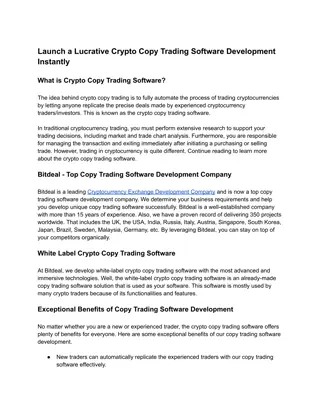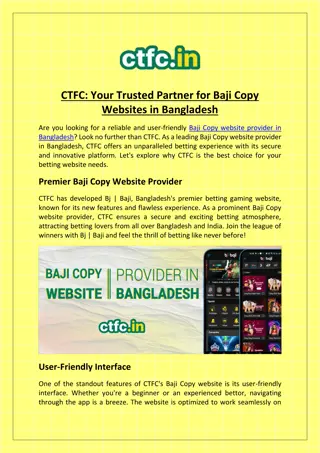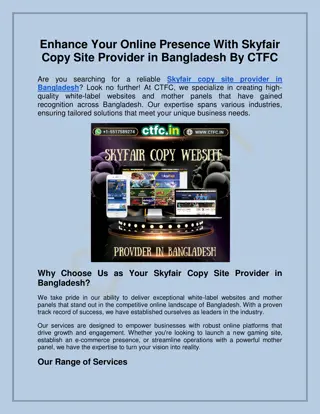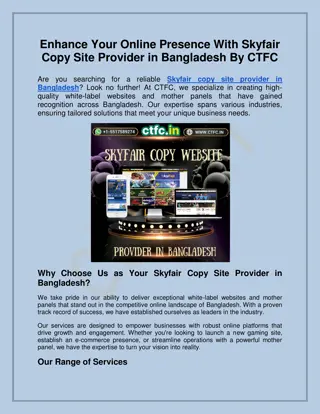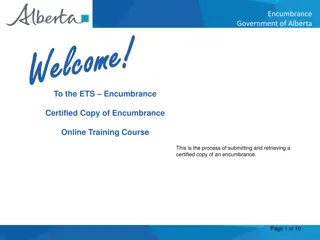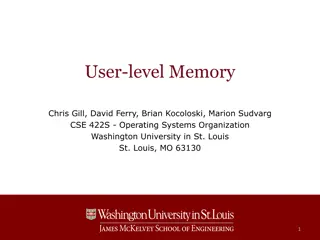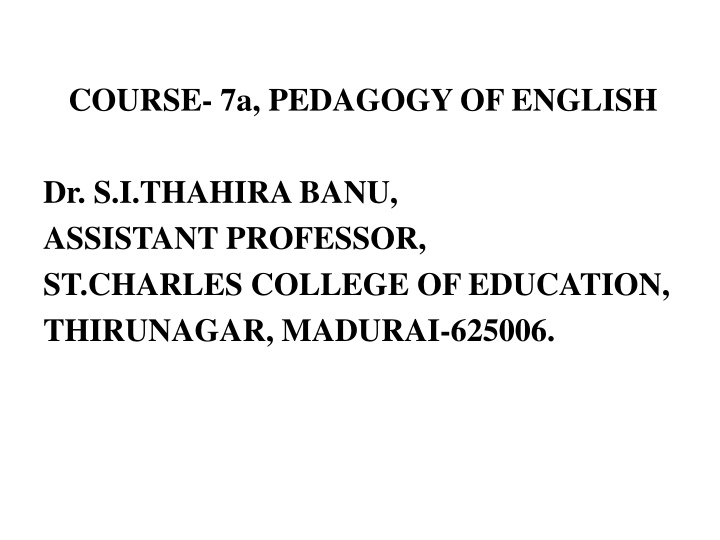
Insights into Teaching English Language: A Comprehensive Overview
Explore the essential aspects of teaching English language, including aims, objectives, importance, principles, and a situational approach. Dive into the significance of mastering spoken, written, and reading skills, and discover the role of English in various contexts.
Download Presentation

Please find below an Image/Link to download the presentation.
The content on the website is provided AS IS for your information and personal use only. It may not be sold, licensed, or shared on other websites without obtaining consent from the author. If you encounter any issues during the download, it is possible that the publisher has removed the file from their server.
You are allowed to download the files provided on this website for personal or commercial use, subject to the condition that they are used lawfully. All files are the property of their respective owners.
The content on the website is provided AS IS for your information and personal use only. It may not be sold, licensed, or shared on other websites without obtaining consent from the author.
E N D
Presentation Transcript
COURSE- 7a, PEDAGOGY OF ENGLISH Dr. S.I.THAHIRABANU, ASSISTANT PROFESSOR, ST.CHARLES COLLEGE OF EDUCATION, THIRUNAGAR, MADURAI-625006.
UNIT: I AIMS AND OBJECTIVES OF TEACHING ENGLISH 1. The aims and objectives of teaching English 2. The rationale for learning English 3. The importance of four language skills 4. Learn the significance of spoken skill.
Importance of English language in India 1. As an official language of administration 2.As a language of the court 3.As a language of International trade and industry 4.As a window on the modern world 5.As a library language 6. On the Internet Some more reasons for learning English English offers the freedom to explore. English fosters creativity English enables learning English develops thinking English promotes participation
FOURAIMS OFTEACHING ENGLISH 1. To enable the students to understand English when spoken. 2. To enable them to speak English. 3. To enable them to read English. 4. To enable them to write English.
Importance ofAims Aims are the direct outcome of the purposes for which language is taught. Without aims we are like the traveler who does not know his destination or even the direction in which he is going. Rightly has P.Gurrey observed, In teaching, it is highly desirable to know exactly what one is hoping to achieve, as it is in all great undertaking. The aims may also be classified as those of reception and expression . Reception means understanding spoken Expression means speaking and writing English. The aims of teaching English have been interpreted in terms of mastery over words and structures. and written English.
GENERAL PRINCIPLES OF LANGUAGE TEACHING 1. Speech before writing 2. Basic Sentences 3. Pattern as Habits 4. Sound system for use 5. Vocabulary control 6. Writing a representation by speech 7. Practice 8. Shaping of responses 9. Immediate Reinforcement 10. Content 11. Teaching for learning outcome.
Situational approach to language teaching A child learns his mother tongue in situations. Likewise, they should learn a foreign language too in situations. The teacher should create appropriate situations language. For example, while teaching certain words like box, watch, mango, etc. the teacher may show the objects to the students. to teach the
The Relationship between Language & Culture and the Implications for Language Teaching Culture refers to the total life system of a particular community race or a human race. Culture involves thoughts, beliefs, traditions, language and values of people belonging to a community. The relationship between language and culture is deeply rooted. Language is used to maintain and convey culture and cultural ties. Different ideas stem from differing language use within one s culture and the whole intertwining of these relationships start at one s birth.
UNIT II: PLANNING FOR INSTRUCTION 1. The instructional objectives with reference to Bloom s taxonomy. 2. Designing of lesson plan 3. The steps involved in writing a lesson plan. 4. Writing a model lesson plan.
Elements of Designing a Lesson Plan 1) Anticipatory Set - A short activity, dispatch or prompt that focuses the students' attention and ties previous lessons to today's lesson. 2) Purpose - An explanation of the importance of this lesson and a statement concerning what students will be able to do when they have completed it. 3) Input - The vocabulary, skills, and concepts to be learned. 4) Modeling - The teacher demonstrates what is to be learned. 5) Guided Practice - The teacher leads the students through the steps necessary to perform the skill using multiple modalities. 6) Checking for Understanding - The teacher uses a variety of questioning strategies to determine if the students are understanding. 7) Independent Practice - The teacher releases students to practice on their own. 8) Closure - Areview or wrap-up of the lesson.
III - BLOOM'S TAXONOMY LEARNING DOMAINS - DETAILED STRUCTURES 1. Bloom s taxonomy - Cognitive Domain - (Intellect - Knowledge - Think) COGNITIVE DOMAIN. 1 Knowledge. 2 Comprehension understand meaning. 3Application use or apply. 4 Analysis interpret elements. 5 Synthesis. 6 Evaluation.
2. Bloom's taxonomy - Affective Domain - (feeling, emotions - attitude - 'feel') 1 Receive. 2 Respond. 3 Value 4 Organize or Conceptualize values. 5 Internalize or characterize values.
3. Bloom's taxonomy - Psychomotor Domain - (physical - skills - 'do') 1 Imitation 2 Manipulation 3 Precision 4Articulation 5 Naturalization
UNIT III: PRACTICING THE SKILLS IN TEACHING OF ENGLISH 1. Teaching of various skills in second language teaching-learning. 2. Mini-teaching lesson plan writing. 3.The teaching methods grammar and composition. 4. Vocabulary and its strategies to enrich their vocabulary. of prose, poetry,
What is teaching? Teaching knowledge to students, nor merely giving advice. The best approach to understanding the nature of teaching is establishing a harmonious relationship student and subject. Teaching is the activity of facilitating learning. is neither merely imparting between teacher,
What is learning? Learning is defined as nothing but Change in behaviour occurs by activity, training or experiences . Learning happens while knowledge is generated in an environment, where interaction between teachers, students and content takes place in interactive ways.
I - SKILL Skill means ability to do something well or expertness. Teaching Skills Teaching skill is a set of teacher behaviors which are especially effective in bringing about the desired changes in pupils. 1. SKILLOF INTRODUCING ALESSON OR SET OF INDUCTION Use of previous knowledge (UPK) Preliminary attention gaining (PAG) Use of appropriate device (UAD) Arousing motivation (AM) Relevance and Continuity or Sequencing of questions and Statements (RC) Topic Declaration (TD)
2. Skill of Explaining: Explaining skill makes the pupils to understand ideas, concepts and principles, a teacher has to explain vividly. Explanation is a set of inter relation statements made by the teacher related to an idea or phenomenon. Components of Skill of Explaining Cognitive Link (CL) Use of illustration (ILL) Comparing and contrasting (CC) Meaningful repetition (MM)
3. SKILLOF QUESTIONING Questioning has two aspects i.e. 1. Fluency in questioning and 2. Probing questioning. Fluency in questioning refers to the rate of meaningful questions asked per unit of time. Probing questioning refers to depth in a pupil s response by asking a series of subsequent questions. Introductory questions Thought provoking questions Prompting questions Information seeking questions Refocusing questions Redirected questions Increasing critical awareness questions Open ended questions High order questions Yes or No type questions Recapitulatory questions etc.
4. PROBING QUESTIONING The skill of probing questioning involves going deep into student responses through step by step questioning with a view to eliciting the required responses. No response situation Wrong response situation Partially correct response situation Incomplete responses situation Correct response situation. The components are, Seeking further information (SFI) Re focusing (RF) Re directing (RD) and Developing critical awareness (DCA).
5. SKILLOF STIMULUS VARIATION The teacher s behaviour influences pupil s attention. Variation in stimulus secures more attention among the students. The following components of the skill, stimulus variation, teaching learning process effectively. Teacher s movement (TM) Pupil s movement (PM) Teacher s gesture (TG) Sensory focus (SF) Change in voice (CV) Change in interaction pattern (CIP) Pausing (P) Audio visual switching (AVS) influence the
6. SKILLOF REINFORCEMENT All pupils generally need social approval of their behaviour. When they answer a question, they are eager to know whether their answers are correct or not. When they are appreciated for the correct answers they are eager to continue their responses in future also. This increases their participation. The appreciation for correct responses is positive positive reinforcement are used for strengthening the responses or behaviours of individuals. Positive verbal reinforcements (PVR) Positive nonverbal reinforcements (PNVR) Negative verbal reinforcements (NVR) Negative nonverbal reinforcements (NNVR) reinforcement. The
7. SKILLOF BLACK BOARD USAGE Black board is the powerful teaching aid to teach from KG to PG. Black board, the visual aids is widely use in all sections of education and training. The development of information and communication technology is reducing the chalkboard work. Legibility (L) Size and alignment (SA) High lighting main points (HMP) Utilization of the space (US) Correctness (C) Position of the teacher (PT) Eye contact with pupils (ECP) Cleaning of black board (CB)
8. SKILLOF CLOSURE In closure or recapitulation, the teacher can consolidate the main points by putting a few questions based on the topic taught. The questions should be logically liked to cover the whole lesson as summary of the lesson. Consolidation of Major points (CMP) Providing opportunity to apply new knowledge to a new situation or different situation (OP) Linking previous knowledge to new knowledge and new knowledge to future knowledge among the students (LK) Homework orAssignment (HW)
SKILLOF FLUENCY IN COMMUNICATION Meaning Resolution for conflict, understanding of the topic. Presentation skills, storytelling, organizing communication style depending on the audience. Cultural sensitivity. Correct use of grammar, correct pronunciation, correct spelling, and concise verbiage without excess words. Knowledge in specialized topics, familiarity with idiomatic expressions. Language translation (if necessary). argumentation ideas. skills, the Adjusting
Components Communication Speaking Accuracy Grammar Vocabulary Pronunciation Intonation. of Skill of Fluency in
UNIT IV: TEACHING AND TESTING LANGUAGE SKILLS MEANING OF LISTENING SKILL Listening is an important skill and must be learnt and taught carefully. Unlike hearing, listening is always purposeful. Jane Willis writes, Listening is receptive rather than productive, but it is an equally important skill.
TYPES OF LISTENING A. Intensive Listening: Intensive listening aims at detailed comprehension of meaning and linguistic exercises. B. Extensive Listening According to Peter extensive listening, the students do not reinforce or practice a grammar point which is linked to the rest of the course work. The two sub skills of listening are: Listening for perception Listening for comprehension Hubbard et.al, With
STUDENTS LISTENINGACTIVITIES In a listening exercise, the class can / should: (i) Take notes (ii) Draw pictures etc. (iii) Talk in reply (iv) Discuss for or against the topic (v) Complete a flow chart (vi) Say True or False (vii) Continue the dialogue (viii) Fill in a table (ix) Write (x) Think (xi) Select (a, b or c) (xii) Discriminate (e.g., ship or sheep) (xiii) Place in correct order (e.g., pictures or pieces of information).
Comparison of Skimming and Scanning Skimming is a reading strategy used for developing reading skill. By using students quickly survey the text to get main idea. Scanning is similar to skimming, a reading skill used for developing reading by using scanning students make quick survey of the text to find specific information . Intensive reading involves students in reading detail with specific learning aims and tasks. It is to learn the content of the subject. The learners read any information with concentration. Extensive reading is reading for pleasure and gaining extra knowledge. For example, reading the story and reading books in library. skimming strategy,
METHODS OFTEACHING READING 1. TheAlphabetic Method. 2. The phonic Method. 3. The word Method or the Look and the Say Method. 4. The Phrase Method. 5. The Sentence Method.
Criteria for selection of English Reader 1. Subject matter: It should be suitable for the students for whom the book is meant. 2. Style: In the matter of style simple style should be used. Graded vocabulary and sentences should be there. 3. Form: The form should be a model of composition with a beginning, middle and an end. Three should be some illustrations and pictures. 4. Exercises: Notes and exercises must follow the lesson proper. Note suggestive. 5. Price: The price of the book should be affordable. should be short and
Unit V: METHODS OF TEACHING ENGLISH 1. Various methods in teaching of English. 2. Different kinds of approaches in teaching of English. 3. Various teaching resources/aids. 4. The recent trends in teaching of English.
METHODS 1. Grammar Translation Method Grammar should be taught deductively that is grammar should be at first presented and studied and then practiced through a translation exercise. 2. Bilingual method: Starting with the reproduction / performance of a basic dialogue. 3. Direct method: The method aims at intense oral interaction in the classroom, so as to develop oral communication skills of the student. 4. Audio Lingual Method: The term audio lingual was coined by professor Nelson Brooks in 1964. The army programmes was to make the students attain conversational proficiency in a variety of foreign languages. 5. Dr. West s New Method Dr. Michael West has laid a great deal of importance to Reading. He has said that for Indian pupils Silent reading is important, no doubt, but Loud Reading is equally important. In this method a good deal of importance has been attached to the art of speaking and reading together as they are interrelated.
Other Methods in Teaching English 1. Silent way method 2. Total physical response (TPR), 3. Dogme language teaching 4. Pimsleur language learning method 5. Michel Thomas method.
APPROACHES Structural teaching of English means approaching English on the basic of structures. Situational Approach: In this approach English is basically taught in the same way in which the child learns his own mother tongue. Communicative Approach: The communicative approach is based on the idea that learning language successfully comes through having to communicate real meaning. Eclectic Approach: Eclectic approach means the collections of all the good points of different methods and then using them for teaching something. Approach: Structural approach in
Recent trends in communicative approach Content based instruction: language can be instruction is a powerful tool for language instruction. Content-based instruction focuses on content rather than language. Task based Instruction: TBI claims that language learning will result from creating the right kinds of interactional processes in the classroom, and the best way to create these is to use specially designed instructional tasks. Text based Instruction: The second level of learning that occurs with text-based instruction is that of learning content through interaction with texts. Learning Content-based a new difficult.
Recent trends in teaching English: Learner- centered teaching model Resources in teaching English Teacher madeAids Flash cards Pictures Charts Models Blackboard
MechanicalAids Overhead Projector Tape recorder Radio Television Language lab Power point presentation Websites for teaching English Multimedia Internet for teaching English Newspaper articles in language class Mobiles to learn English Films in learning English English clubs.
Qualities of a good English language textbook: The English reader is as important as a language teacher, as it provides the contents of teaching. It helps teachers revise and strengthen the language material already taught. The textbook is the most important tool in the hands of the language teacher. 1. The language teachers must know the criteria of a textbook. 2. The subject matter should be suitable to the students for whom the book is meant. 3. The presentation of the subject matter should be popular style. 4. The introduction of the vocabulary will be graded and systematic. 5. The form of each lesson will be a model of composition, with a beginning, middle and an end.
Unit VI: TESTING AND EVALUATION IN ENGLISH 1. Test and evaluation patterns. 2. Test and its various types. 3. Construction of test and steps involved in planning it. 4. Blue print and marking scheme and scoring key.
Different kinds of test 1.Achievement test: Achievement tests determine how much of a particular content or subject-matter has been mastered. These are commonly used at the end of school terms. 2.Aptitude test: Aptitude tests try to predict how well a student will succeed in learning the second language.
3. Proficiency test: Proficiency tests assess how well or how skillfully the students perform the four language skills listening, speaking, reading, and writing. Usually a student s proficiency in listening and speaking are assessed by oral tests. 4. Diagnostic test: Diagnostic tests aim to find out what a student still has to learn in a language. The results of this test provide feedback for a teacher by displaying the learner s strengths and weaknesses.
Types of tests in English For measuring student s language skills and knowledge in English, the following types of tests can be used: 1. Objective-type tests 2. Short-Answer type tests 3. Essay-Type tests.


